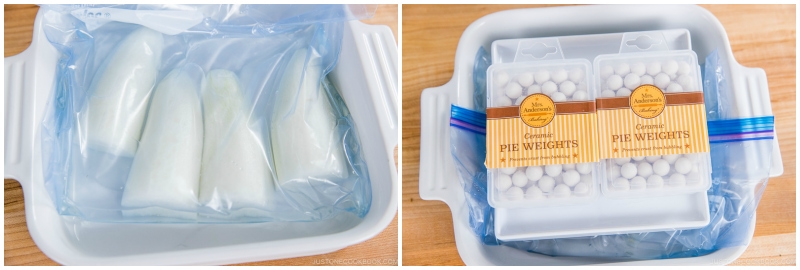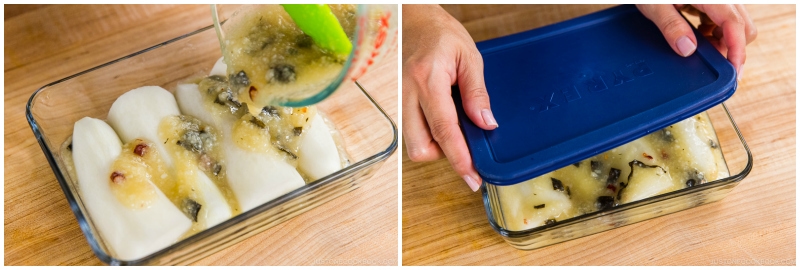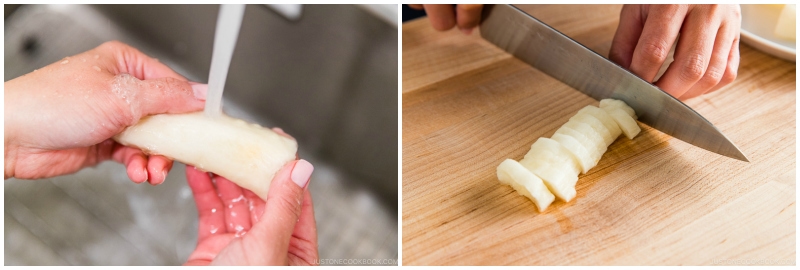Whet your appetite with sweet and savory Pickled Daikon with Shio Koji, an all-purpose Japanese seasoning. Called tsukemono, Japanese pickles make a refreshing side dish and palate cleanser. This easy recipe takes minimal ingredients and hands-on time to make.

In today’s topic, let’s learn about Shiokojizuke (塩麹漬け), a Japanese pickling method using salt koji mold (shio koji). It is one of the easiest types of Japanese pickles known collectively as tsukemono (漬物).
You can pickle all sorts of vegetables with this technique, but since daikon is available year-round, I’ll show you how to make Pickled Daikon with Shio Koji (大根の塩麹漬け).

Tsukemono – Japanese Pickles
Japanese pickles are called Tsukemono. Before we start, if you’re interested in learning more, read Tsukemono: A Guide to Japanese Pickles on my blog.
Tsukemono has several types based on the pickling agent:
- Shiozuke (塩漬け) – salt
- Suzuke (酢漬け) – vinegar
- Amazuzuke (甘酢漬け) – sugar and vinegar
- Misozuke (味噌漬け) – miso
- Shoyuzuke (醤油漬け) – soy sauce
- Kasuzuke (粕漬け) – sake kasu (lees)
- Shiokojizuke (塩麹漬け) – rice koji/mold-cultured rice
- Nukazuke (糠漬け) – nuka (rice bran)
- Karashizuke (からし漬け) – Japanese hot mustard karashi
- Satozuke (砂糖漬け) – sugar
I’ve shared the highlighted pickling methods above in the series, but we’ll focus on Shiokojizuke (salt koji pickling) today.

What’s Shio Koji?
Shio koji (塩麹, 塩糀) or salt koji is a natural seasoning, which is used to marinate, tenderize, and enhance the umami in foods. It’s made of just a few simple ingredients: salt, water, and rice koji.
Because koji (koji mold spores) is a live food that is rich in enzymes, we need enzymes to break down starches and proteins in food (such as daikon in this recipe) into sugars and amino acids respectively. This process makes the food naturally sweet, aromatic, and rich in umami.

Health Benefits of Shio Koji
Because it is a fermented ingredient, shio koji is known for its many health benefits, which include (source):
- A natural pro-biotic seasoning
- Tenderizes food
- Brings out the umami and sweetness in foods
- Reduces the intake of salt
- Aids for digestion
- Clear the skin
- Anti-aging
- Contains minerals, fiber, and vitamins

Where to Get Shio Koji
You can make Shio Koji from scratch if you can find koji at a Japanese grocery store and have the patience to make it.
I purchase my favorite Hikari Miso Shio Koji at my local Japanese grocery store (Nijiya Market). You can find it at Japanese grocery stores and a big Korean grocery chains like H-Mart. Check at the condiment section or refrigerated section of the store.
Also, you can purchase it on Amazon.
When you open the bottle, you will immediately notice the sweet smell that reminds you of sake. With the help of all-natural koji, you will notice a significant flavor boost in your daily cooking!

How to Use Shio Koji
You can use shio koji to marinate your meats and vegetables, make pickles, or use it as a salt substitute. Shio koji is REALLY versatile and I’ve used it to make some delicious recipes on Just One Cookbook.
If you’re not sure, start using shio koji to replace salt. In a recipe that calls for one teaspoon of salt, you can substitute it with two teaspoons of Shio Koji. You will not only get the “salt” effect but also experience the “umami bomb” effect!
3 Steps to Pickle Daikon with Shio Koji
Hands-on time for this recipe is very minimal. I usually make this recipe while I am preparing for dinner and have some time in the kitchen. Here are the 3 easy steps:
- Step 1: Remove moisture from daikon – Soak daikon in saltwater overnight.
- Step 2: Make shio koji mixture – Make a flavorful shio koji mixture.
- Step 3: Pickle daikon – Put the daikon in the mixture for several hours up to 2 days.
See the recipe below for detailed instructions.
The pickled daikon makes an ideal accompaniment when you serve rice and miso soup. It’s a palate cleanser and you only need 2-3 slices for each person. Serve them on a tiny plate (mame-zara), or on a medium plate where people can take as much as they like.
Other Shio Koji Recipes on Just One Cookbook
- Shio Koji Chicken
- Braised Herb Chicken with Shio Koji
- Shio Koji Karaage
- Grilled Mackerel with Shio Koji

Wish to learn more about Japanese cooking? Sign up for our free newsletter to receive cooking tips & recipe updates! And stay in touch with me on Facebook, Pinterest, YouTube, and Instagram.

Pickled Daikon with Shio Koji
Ingredients
- 1.1 lb daikon radish (if your daikon comes with leaves on top, try this Daikon Leaves Furikake (Rice Seasoning) recipe or add it to miso soup instead of chopped green onion)
- 1 cup water
- 1 Tbsp Diamond Crystal kosher salt
For the Shio Koji Mixture
- ½ cup shio koji
- ¼ cup sugar
- 1 piece kombu (dried kelp) (6 g; 3 x 3 inches, 8 x 8 cm)
- 1 dried red chili pepper
Instructions
- Gather all the ingredients.

Day 1
- Combine 1 cup water and 1 Tbsp Diamond Crystal kosher salt and mix well. Peel 1.1 lb daikon radish.

- Cut the daikon in half widthwise and in half lengthwise. If your daikon is thinner, you may just cut in half widthwise.

- Put the daikon in a resealable plastic bag and add the salted water. Remove the air and seal tightly. Daikon has strong-smelling sulfur compounds and it gets quite smelly. If you decide not to use a resealable plastic bag, you will need a large airtight container such as a big jar that can include the daikon, saltwater, and heavy objects on top of the daikon.

- Put the bag in a tray to avoid any leakage and put a heavy object on top of the bag. Here, I put a plate on top (to evenly distribute the weight) and pie weights. Set aside at room temperature overnight.

Day 2
- To make the shio koji mixture, combine ½ cup shio koji and ¼ cup sugar in a 1-cup measuring cup (or bowl). Cut off the end of 1 dried red chili pepper with a knife or a pair of scissors.

- Remove and discard the seeds (typically, the Japanese do not include the chili seeds and use just the pod for mild spiciness). Cut the red chili pepper into small rounds and add to the mixture.

- Cut 1 piece kombu (dried kelp) into thin strips and add to the mixture. Mix all together. Set aside.

- Remove the heavy objects, and take out the daikon. Discard the salt water.

- Wipe off the moisture on the daikon with a paper towel.

- In an airtight container that fits the daikon, pour half of your shio koji mixture into the bottom of the container. Put the daikon on top.

- Add and distribute the rest of the mixture. Put the lid on and keep at the room temperature for 2–3 hours, then transfer to the refrigerator for 2–3 days.

When to Stop Pickling
- You can eat the pickled daikon starting the day you add the shio koji mixture. It’s up to you when you want to stop pickling. You can take out all the daikon after one day, for example. As time passes, the daikon releases more moisture and the kombu gets more slimy. When the daikon is pickled enough to your liking, take them out and transfer to another airtight container to keep for a week or two. I usually remove and eat one piece of daikon each day and finish all of it by the 3rd day.

To Serve
- If you prefer to serve pickled daikon without the koji (grains), you can quickly rinse under running water. Cut the daikon into ¼-inch (6-mm) slices and enjoy!

To Store
- After taking out the pickled daikon from the mixture, store the pickles in a jar or container with a tightly sealing lid to minimize the odor. The pickles will keep in the refrigerator for 3–4 weeks, but I recommend consuming them sooner as the odor gets stronger as time passes.
























Hi Nami-san, i just wonder if shio koji is already umami why u need to add more kombu in this recipe? Thank you
Hi Chindy! Thank you very much for reading Nami’s post and trying her recipe!
Tha Shio Koji and Kombu have different flavors and each of them works well with this dish.
You can make this dish without Kombu but you will notice the deep Kombu’s Umami flavor is missing.
We hope this helps!
So good! Tastes just like in Japan. I’m making more today, and I haven’t even finished the first batch. Thanks Namiko!
Hi Dan! We are glad to hear you enjoyed Namiko’s pickled recipe!
Thank you very much for trying this recipe and for your kind feedback!💕
Hi,
Why din’t you dry the daikon with just salt like when you pickled it in soy sauce ?
Thanks.
Hi Adrien! For making pickles, there are many different ways, including these pre-salting methods.
You can use either method. Shio Koji pickles take a longer time to finish, so it’s not a “quick pickling” recipe. We use more proper saltwater method.
My soy sauce pickles are meant for quick pickling, so we use the short-cut method of salting.
It’s up to you the method you use. 🙂
Can you use the remaining mixture as a pickling bed for something else ?
Do you usually throw it away ?
THANKS !!
Hi Adrien! I recommend not to use it because water is released from the daikon. 🙂
Hello! I have a friend from Japan who loves tsukemono! I thought I’d try making this for him. 🙂
I wondered about the dried chili pepper though… Would there be any way to substitute that for chili powder or something like that? I’m worried that I won’t be able to use them all if I buy a whole bag of dried chili peppers.
Thanks for all your recipes! They’re great!
Hi Susanne! I also don’t use it all the time, so my red chili pepper is more than 1 year old… I just keep them in an airtight jar. Japanese always use one red chili pepper (without seeds) in one dish. 😀 You can skip it but I don’t recommend using chili powder. I think it’s a different type…
Hi Nami-san! I made oden for my dad with your daikon shiokojizuke and daikon leaf furikake tsukemono side dishes . Came out great, but it was a little sweet for my taste (but my dad loved it, and that’s all that matters). Next time I’ll adjust sugar a little. My question is, now that I have left over shiokoji, can I reuse it by adding additional daikon? Will it be too watery to work with additional daikon?? What do you think? OH! and I stuffed the daikon leaf furikake into some rice and gave it to him as onigiri. He loved that too!!
Hi Yosh! Yes, please adjust the amount of sugar next time. 🙂 Daikon releases the water to shio koji mixture so it won’t be the same result. I’d adjust the amount of shio koji mixture to use less amount for pickling. I’m really happy to hear your father enjoys all these dishes! I just had daikon leaf furikake with my brown rice this morning too. SO good!
Nami thank you! I have just impulse-bought some packaged pickled daikon, and I really should have known better. Can’t wait to finish it off so I can try this recipe.
Hi Helen! It’s quite hard to find pickles that are “clean” (no preservatives etc). Hope you will try pickling at home one day! 🙂